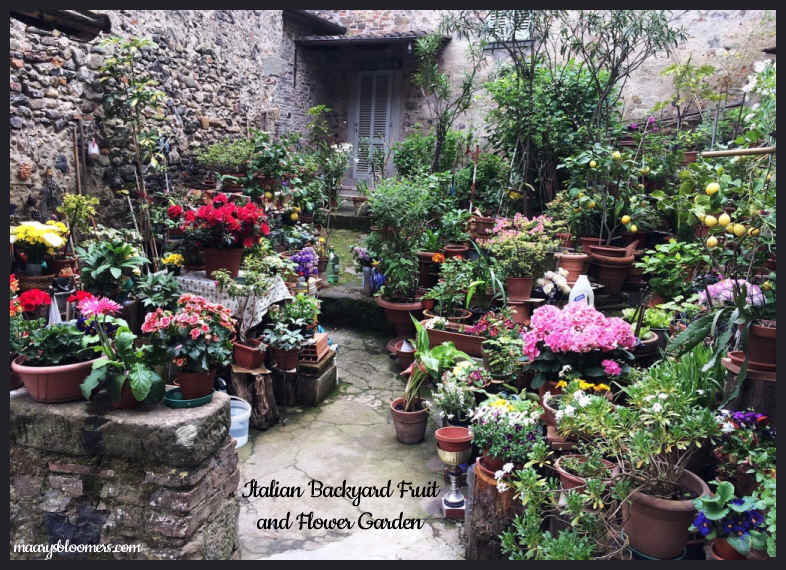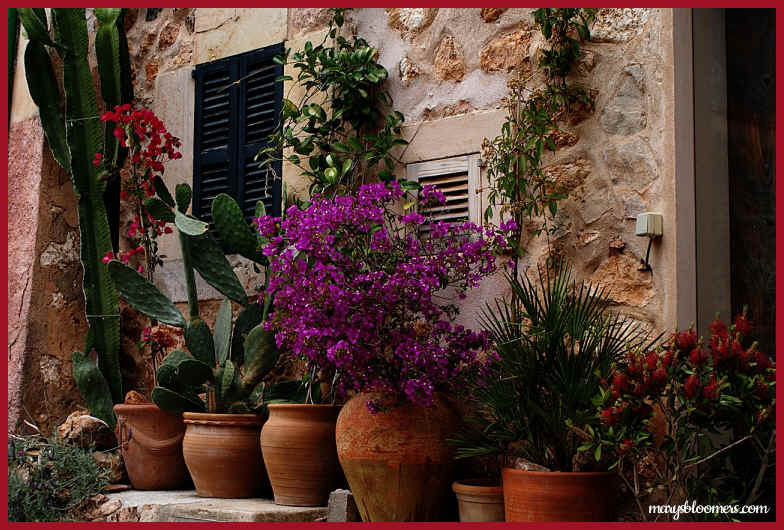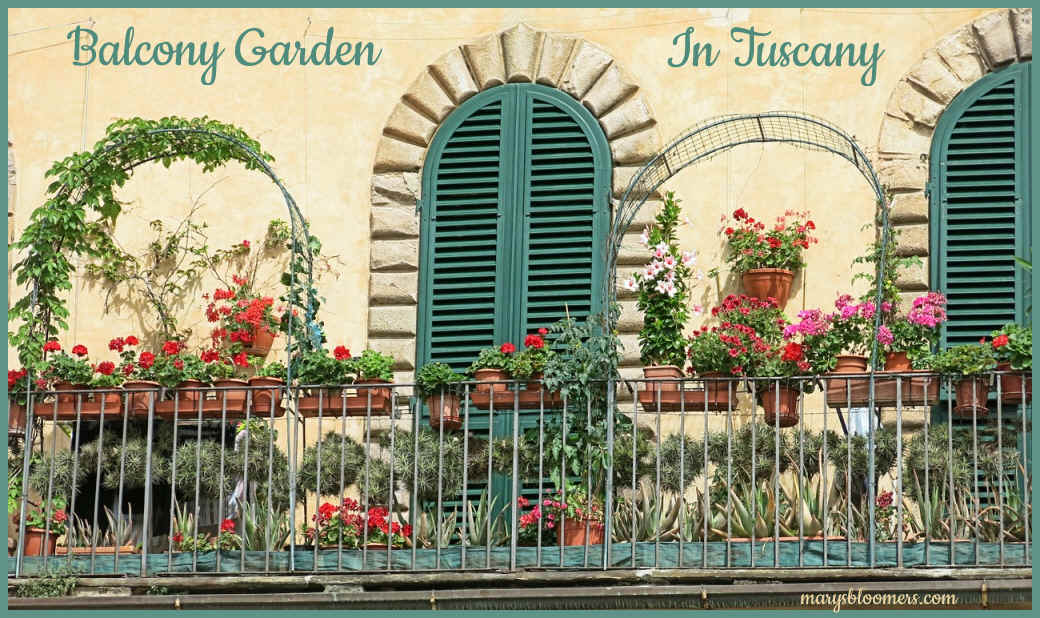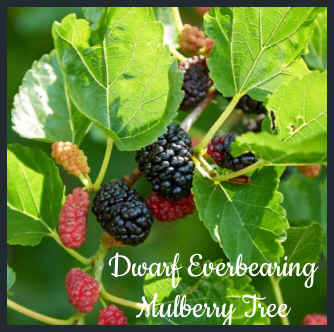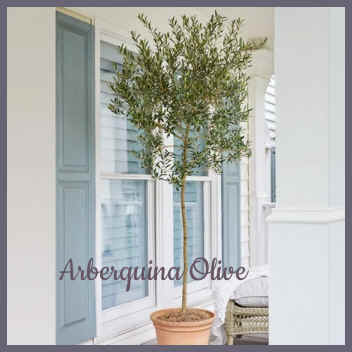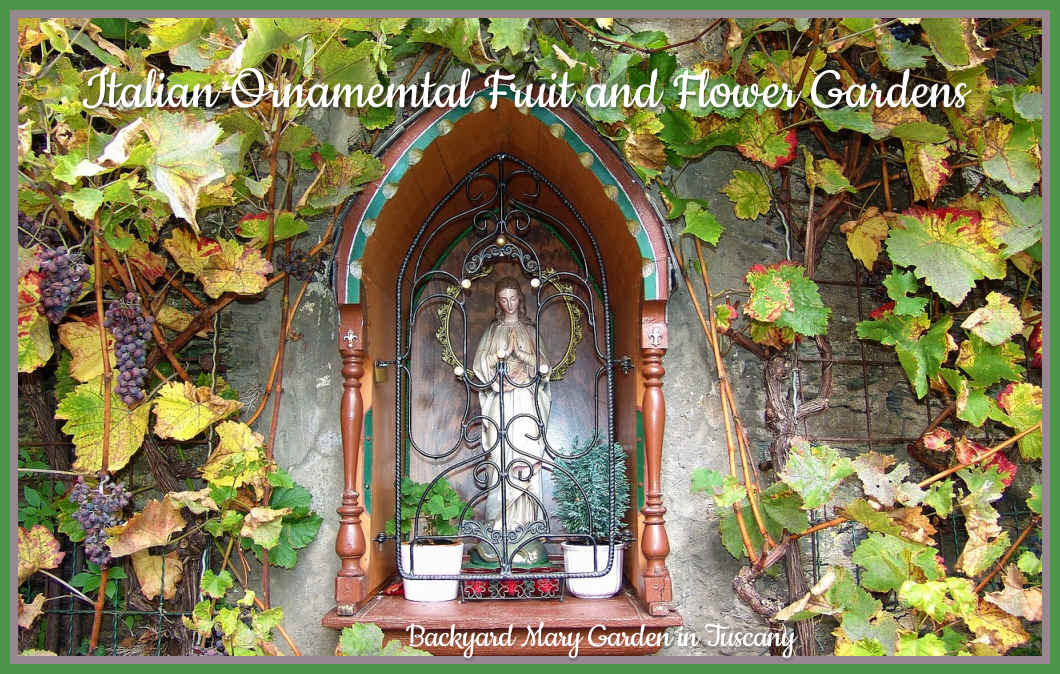 |
Designing An Italian Fruit and Flower Garden
| Italy has more than 25 million acres of
farmland which produce a variety of vegetables and fruits that are major
components of the country's cuisine. Gardening and fresh produce is an
important part of the Italian lifestyle, particularly home
gardens. Italy has well-known fruits and vegetables that
flourish in its rich soil.
The Tuscan garden is a good choice of Italian garden style and the style can suit all budgets and many natural gardening philosophies. If you or your family are of Italian descent, you'll love the nostalgia and mediterranean feel of a traditional Italian ornamental fruit and flower garden. Wildflower meadows were encouraged in order to provide hay for the farm animals, and many beautiful wildflower pastures can still be seen, overflowing with poppies and wild mustard. Tuscan farmers' wives can still be seen collecting fresh herbs from these wildflower meadows in order to feed, fatten and flavor the meat of their rabbits and to create natural medicines from their natural garden medicine cupboard. Wild Tuscan flower meadows once provided everything that the modern pharmacy supplies: cures for colds, fevers, and many other ailments. Old terracotta urns, once used to store wine and olive oil, can now be found around farmyards, planted with geraniums or sedums. To begin your Italian-Style ornamental and fruit tree garden, begin with the fruit trees and shrubs, then make your way to the traditional Italian garden flowers and ornamental focal points. Make a list of what you love to eat, not just what you want the garden to look like. You can "see" a Mediterranean terrace, but you will want to "eat" an Italian fruit garden. While sitting on that terrace. It was fascinating to view photos of gardens in Italy and realize that most of their gardens contain potted plants and trees. My favorite type of gardening these days. It has so much decorative possibility, and it makes your garden portable and easy to care for. My grandmother, an Italian immigrant, worked the potted garden idea when she came to America, for her teeny-space NYC garden. The one on the fire escape outside her kitchen window. Lots of clay pots filled with basil, oregano, tomatoes and everything she needed to make her spaghetti sauce. I grew up with a distinct affinity for clay pots.
The first thing you must begin with is that focal
point.... The stone or stone-look fountain or Roman artifact. Even a
large, ornate birdbath. Around which your garden
design will grow. Or more than one. And perhaps you can tuck in a few
Roman statues of gods and goddesses. Not too big, just something to
stand out in your orchard landscape. If you grow grapes on an arbor,
have A plaque or bust of Bacchus, a Mary nook, the stone urns
embellished with grapes. If you have a
fence, you're blessed. There are small, decorative wall plaques with
Roman and agricultural themes, and ornamental fonts you can hang. There
are solar wall fountains that are purely ornamental, but the sound of
water is quite soothing in lieu of oceanfront. If you are interested in incorporating a little sacred
Mary Garden into your plan, click here
to read about the custom and how to grow one. You only need
a teeny nook for a dedicated Mary Garden within your landscape. It's a
very beautiful tradition in many European gardens. It doesn't matter how
small it is, it can even be part of a balcony garden, or a large
succulent pot, as long as a statue of Mary, big or small, is in it.
A couple of big, Italian-style urn planters to accent the rows of plain
pots, or to use around your fountain. A reminder..... dwarf fruit trees are just
pint-sized trees with full-sized fruit, and they bear fruit in half the
time as standards. Just so you know. The crops may be a wee bit smaller.
If that's an issue.......Plant More Trees!
What to grow - Traditional Italian Flowers and Succulents Check the USDA cold hardiness map for your area to decide what variety of fruit, and which varieties of flowers will thrive in your region over the winter. You can bring the non-hardy indoors for the winter and stick them in a cold basement or garage when they go dormant, but that's a pain in the neck. Been there. Most fruit trees are available in hardy varieties. Except most citrus trees. You'd have to find a hybrid or haul them around. Mediterranean gardens will generally mean plants that like living in a warmer region, near water.
Quince trees are a cousin of the apple and pear tree, and are hardy in USDA zones 5 through 9. Growing quince trees is easy, as long as you can provide appropriate conditions. Choose a sunny location with fertile soil. Quinces adapt to wet or dry soils but perform best when the soil is well-drained. The tree itself has character, tending to grow into an irregular shape with twisted branches. Its flowers, which appear in June, are single, large and pink-white. The large fruits ripen to golden-yellow and it has strikingly large leaves, which are grey and furry underneath. The fruit itself is yummy. Quince might have been the fruit with which the serpent tempted Eve, rather than the apple. Quince trees live a long time, and four really old-timers live in the Cloisters Museum in NYC. The fruit has to be cooked, because it's too hard to eat fresh. if you stew it in a pan it will cook in about fifteen minutes. Its slightly spicy, intensely rich flavor combines excellently with apples or dried fruit. The fruits smells like pineapple. A bowl of quinces will scent a room. Quince will tolerate most soils. If planting in-ground, light soils should have plenty of compost added before planting and a thick organic mulch applied every year. It could be trained against a wall and recently a patio Quince has been developed for smaller spaces and pots. Being self-fertile, only one tree is needed. Once established, quince trees need very little pruning, and pruning should be done in winter. The fruit ripens gradually to a rich yellow and it should be left on the tree as long as possible to allow the flavor and perfume to develop. Ideally this means until the end of October. If frosts threaten, gather them before the cold gets them. Storing demands a little thought since their perfume will affect any fruit stored nearby. Put them where they don't touch each other, and check regularly for rot. The fruit will keep for around 3 months. Quince can used in savory dishes to accompany meat, but also to make a cheese or jelly, and is the secret to a really awesome apple pie. I read that you'll never again want to eat one without quince added in. (Dwarf Everbearing) Mulberry Trees in pots
Lemons are one of the most common fruit trees in Italian gardens, for cooking, medicinal use or ornamental purposes. The fruit grows slowly on the trees from a light green to a bright yellow, large fruit with a thick rind. They grow in sunny areas and must be brought indoors for regions with cold winters. Lemon trees grow well in the southern areas of the country, and the flavor will vary from sweet to sour to tangy depending on the surrounding soil and region. Lemons are used not only for decoration, but eaten fresh, used in seasoning (for the acidic flavor), grilling, made into juice and added to beverages. I have a few dwarf lemon trees in pots that have to come inside for the winter (zone 6). They don't go dormant, and they don't drop their leaves. They make exceptionally pretty house trees in the winter, with their glossy leaves. They don't really take up much room and they bloom like crazy, spreading fragrant joy when you walk by. Mine are Dwarf Meyer Lemon trees, now outside for spring, summer and early fall. I have a few teeny lemons already growing on the stems that flowered. By the way, they are self-fertile so you only need one tree. They come in again before the first hard frost to decorate my home in the dreary months until spring. Many Italian gardeners used chicken manure that has been soaked for 10 days in a trashcan full of water. This makes a strong, effective and organic liquid fertilizer for lemon trees. Lemon trees require some light pruning of the older stems in the spring, but be careful to not remove too many of the fruiting stems as they will need at least a year to re-grow and produce fruit. The glorious and culturally historic fig tree The fig tree is a common addition to any Italian garden because it is one of the easiest fruit trees to grow. Figs are a fruit that resembles a light green plum on the tree, with a pink tender flesh on the inside. When dried out, figs become silver dollar-sized and soft, ranging in color from tan to purple. They have a sweet, tart flavor and are often incorporated with cheese and wine dishes, salads, eaten raw or used as an ingredient in sauces. When figs flourish in the wild, they grow on rocky hillsides to absorb full sunshine. When growing at home, fig tress will thrive in any area with full sun and require little maintenance or pruning. There aren't many truly cold hardy fig trees for northern gardeners. So I've planted a few of the hardiest dwarf varieties in big pots, and plan to house them in a cold indoor area in my basement once they go dormant until spring. I won't be doing the traditional wrapping and burying routine. Got no time for that. Read about Italian Immigrants and the Fig Tree--> Read about dwarf potted fig trees and how to espalier a yard full of dwarf fig and other fruit trees along a fence---> A cherry tree is a classic tree in the Italian garden. The best for your Italian garden theme is the Morello variety. An Italian garden wouldn’t really be complete without one, but the cherry is a very problematic and slightly difficult tree to please. The cherry is prone to fungus attack, which enters through pruning wounds or wind-damaged branches- making pruning the cherry tree a slightly complicated and frustrating endeavor. All of my cherry varieties have had one minor problem or another, except for the dwarf weeping ornamentals and the Lapins dwarf variety of edible cherries (tastes like Bing) and can grow in a big pot. You don't have to grow the exact varieties grown in Italy, grow what will survive and reward you with lots of sweet fruit with little headache. Olive are an important tree in Italy, particularly for olive oil production that dates back to 7th century B.C. Italy is the second largest olive producer in the entire world, Olive trees can grow in fields for miles, with colors ranging from black to green to pink. My ancestors had farms and olive tree groves. Besides olive oil production, olives are used often in cooking--mashed into tapenades or with pate, eaten raw, added to sauces, pizzas, popped into your martini, in salads, sauces or grilled on skewers with meat or other vegetables. And yes, you can grow dwarf olive trees in a pot. The Arbequina Olive Tree is fast-growing, early flowering, and grows high quality olives. Arbequina Olive Trees are adaptable to a wide variety of soil types and conditions. They bloom fragrant blossoms that produce a heavy harvest of fruit. The Arbequina Olive Tree can be grown in the ground in USDA Zones 8 to 10, and in a pot in Zones 4 to 7.
Arbequina Olive Trees grow to a height of 15 feet, can be pruned shorter, and can tolerate temperatures as low as 20 degrees F (that zone hardiness mentioned doesn't jive with 20 degree lows for zone 4) Therefore i call bring them in for the winter. They do best in well drained soil and full sun. Since the trees are small, you can grow one in a smaller garden or even in a container on a patio or deck. These are drought tolerant and not bothered much by insects. The most cold-hardy include: Arbequina, Ascolana, Mission and Sevillano. But you can grow any variety of dwarf olive if you grow in big pots and over-winter them indoors. Italian Plum Trees Italian plums are a sweet, oblong fruit. This tree is perfect for home-growers in the United States because Italian plums are rare finds in supermarkets, so a tree of your own will give you a steady source of these seasonal fruit. Italian plums, are also called Italian prune plums. They look much different than the commonly available plums. Italian plums are about the size of a large strawberry, and they have an oblong shape. Perfect for grabbing and popping into your mouth while you relax in the garden. Removing the pit is fairly easy because they are have a freestone pit, meaning that the pit pops right out cleanly, without fibrous bits that hold some pits to the fruit. They look very attractive on a fruit and cheese plate because they're not all runny and chewed-up looking when the pits are removed. These plums are known for their sweet flavor that becomes sweeter with baking. Their firm skin helps them hold up well when baked into desserts or preserved in spirits, like brandy.
I grew up in an Italian neighborhood, and these are the plums i remember offered on fruit-seller pushcarts and in the many indoor/outdoor fruit stands gracing the street corners in Bensonhurst, Brooklyn. . That plum was the most commonly offered, although sometimes there were red plums offered in small quantities. Plum trees grew in the gardens along with the figs. I liked it best because it wasn't so messy when you ate it, and it had a nice texture for cooking, pitting and turning them into prunes, and for making preserves and "drunken" fruit. Although the sweet, juicy red plums were my secret favorite, when no one could see the juice dribbling. It is cold hardy in this area, and I am growing my first dwarf tree in a pot. It seems to be a fast-growing and no-maintenance addition. I cannot find these in grocery stores, so I'm growing my own. It's self-pollinating. These plums are famous for their baking uses in Germany and in the Pennsylvania Dutch culture, particularly in cakes, dumplings and desserts. You can dry your Italian plums into prunes using a food dehydrator, or using the dehydrator function on your air fryer, if it has one. I like to just eat the prunes plain, but you can later use them in baked cakes, pastries, or in trail mixes, stewed, or as sweet salad toppings. Grandma used to give us a super-sweet Prune Butter spread on soft white bread for a snack treat, and the spread was called "Lekvar" in Slavic cultures. Prunes made from Italian plums don't taste like the prunes you buy in the supermarket. It tastes delicious, but it's not a common commercial prune. Many ethnic pastries contain prunes, so dry up a few batches for prune danish and other treats. Alton Brown has written a wonderful recipe for
delicious Sugar Plums for the Christmas holiday. The recipe includes
dried figs and apricots, and I just so happen to be growing those in my
mini-orchard. These plums grow in hardiness zones 5-9. They are the most cold-hardy of the European plum types. You will know when they are ripe, because they will just drop to the ground. Sounds good to me. No climbing, reaching, squeezing or yanking. One good shake every day when ripening, or just waiting for them to fall, will deliver these ripe goodies without guesswork. Grapevines Of course, a grapevine is a great addition, and it
adds architectural value to your Italian Fruit Orchard. Italy has over
two million acres of grape vineyards running along coastlines and
mountains, the third largest in the world, according to the Wine
Institute. Grapes are grown in almost every single region of the
country, and dozens of varieties are produced. Besides wine, grapes are
eaten as fresh fruit, and with cheese platters, and incorporated into
desserts, juice and sauces. You can grow these beauties on garden
arches, arbors and pergolas. They also make awesome espaliers. There are
several cold hardy varieties available for northern gardeners. And
pruned-off twigs make a lot of really neat garden decorations. You can
even save and use the discarded vines woven into free-standing arbors
for roses or wisteria to grow on.
Quick Links
Content, graphics,
photos and design ©2020 marysbloomers.com |
